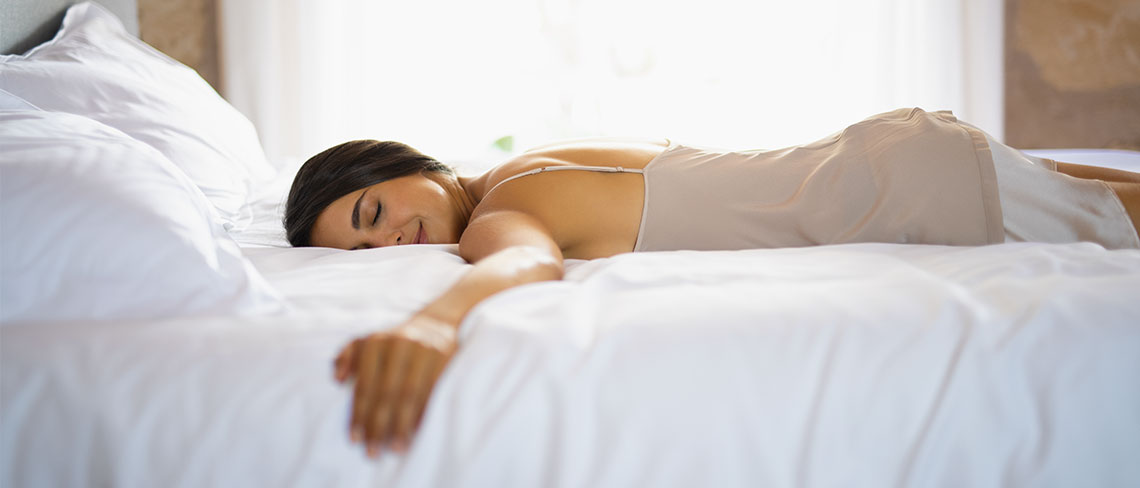
TEMPUR® sleep specialist & sleep counsellor shares guide on how to enjoy a good night’s sleep and alleviate migraine symptoms ahead of Migraine Awareness Week (September 4-13).
Whilst the exact cause of a migraine is often elusive, it is no secret that the lifestyle choices we make can play a key part. Though research into the connection between sleep and migraines is still ongoing, it is widely accepted that a good night’s sleep can help to relieve some of the painful symptoms of migraines– which are estimated to affect approximately 10 million adults in the UK alone.
Thomas Høegh Reisenhus, sleep specialist & sleep counsellor for TEMPUR®, says, “Lack of sleep is a well-known trigger of migraines. Frustratingly, the painful condition can make the remedy of getting a good night’s rest feel like an almost impossible task, creating a vicious cycle whereby you are even more tired and stressed which, in turn, worsens the symptoms.
“When it comes to breaking this negative cycle, the easiest place to start is by looking at your daily routine, especially your sleeping habits. For example, more often than not, seemingly innocent activities – mid-afternoon naps, bedtime scrolls, and weekend lie-ins, to name only a few – can be identified as aggravating migraine symptoms, if not potentially even causing them. It is no coincidence that many of these habits have been linked to reducing sleep quality too.
“Luckily, this means that just a few simple tweaks to your routine can help alleviate both the pain of your migraines and simultaneously improve your quality of sleep too – the latter of which will help to reduce the symptoms further, turning that vicious cycle into a positive one.
“That said, whilst good sleep hygiene can help ease and even prevent migraines, if your symptoms are severe, persistent, or getting worse, do not hesitate to visit a doctor or health professional for support.”
Read on for Thomas’ guide on how to ensure a good night’s sleep and relieve migraine symptoms…
Think about what you drink
Dehydration is a well-known cause of headaches, so drinking plenty of water is a must. It is thought that the average person needs around 7 glasses a day, with tea, coffee, squash, coconut water, and some lower-fat milk options all counting towards this.
Similarly, avoid alcohol. Alcohol can trigger migraine attacks as well as worsen the symptoms by contributing to dehydration and disrupting natural sleep cycles too. Though many think that an evening tipple aids sleep, it is widely agreed that an alcohol-induced sleep tends to be of a significantly lower quality.
Whilst the link between caffeine and headaches remains ambiguous, there is no doubt of its impact on sleep. Caffeine can remain in your bloodstream for as long as 10 hours so it’s best to try and enforce a caffeine cut-off by 2pm at the latest. Beware of hidden sources of the stimulant too; for example, paracetamol, a popular medication of migraine sufferers, often contains caffeine.
Prioritise nutrition
Though nausea is a common symptom of the condition, it is important to try to eat small meals at regular intervals when suffering from a migraine. This should help to prevent any sudden spikes or drops in blood sugar levels, which will only worsen symptoms.
Magnesium-rich foods have been found to lower cortisol levels, ease headaches, and promote better sleep. Therefore, be sure to incorporate foods packed with the mineral into your diet, for example dark-green leafy vegetables, lentils, and whole grains.
On the other hand, aged cheeses (like parmesan and brie), citrus fruits, and dark chocolate should be avoided by migraine sufferers. These foods contain high levels of tyramine, a chemical believed to stimulate the constriction and consequent dilation of your blood vessels, a biological process thought to cause headaches.
Soothe your senses
Heightened sensitivity to bright lights, loud sounds, and certain odours are common symptoms in those experiencing migraines so, when it comes to getting a good night’s rest in the midst of an episode, it is essential that such components are considered. The ideal sleep environment is dark, quiet, and cool.
Try to avoid exposure to harsh lighting, especially in the lead up to bedtime. Artificial bright light, especially blue light, can disrupt your body’s circadian rhythm which is naturally aligned with the light-dark cycles of day and night. This is because it suppresses the production of melatonin – the sleep-inducing hormone that plays a large part in regulating your natural sleep-wake cycle, with heightened levels being released in response to darkness and cooler climes.
Similarly, for bedroom lighting, use lamps (with bulbs that emit a gentle, yellow hue) and candles to create a softer and more natural evening glow – less pain-inducing and melatonin-suppressing than the main light’s harsher offering.
For this reason, it is so important to switch off tech – phones, laptops, and television screens, to name a few – at least one hour ahead of bedtime. In fact, if suffering from a migraine, it is best to avoid unnecessary exposure to bright light altogether.
To remove any temptations, make your bedroom a screen-free zone; for example, swap out phone alarms with analogue alarm clocks, and replace time spent on work emails and watching TV dramas with a gentle stretching routine, breathing exercise or warm bath. This will also help to enforce the mental association of your bed with rest and relaxation, rather than as a place of productivity.
Leaving your electronics outside the bedroom also removes the intrusion of their jarring, high-pitched and sleep-disrupting rings and pings, which only worsen migraines.
Take it easy
Stress has been identified as a common cause of poor sleep (triggering and worsening migraine symptoms); as most people will know, a mind filled with worries can leave you tossing and turning long into the night.
To avoid this, try to establish a relaxing bedtime routine to allow plenty of time to unwind and slow down mentally before attempting to sleep. Mindfulness practices such as meditation, breathwork, and journalling are all screen-free activities which have been shown to help quieten, clear, and calm a busy mind.
Defeat with heat
A warm bath ahead of bedtime can relieve headache symptoms by improving blood circulation, easing muscle tension, and stimulating an increase in the production of melatonin, a response to the body’s drop in temperature following a hot soak.
Add a splash of a natural, essential oil-based bubble bath for added benefits; one made with lavender, with its sleep-inducing and headache-soothing properties, would make a great choice.
Another trick is to place a cold compress or an ice pack on your head or neck, with the cooling properties believed to alleviate migraine symptoms by numbing the pain and reducing inflammation.
Keep it consistent
Unfortunately, you really can have too much of a good thing: an excess of sleep has been linked to inducing migraines too. A change in a person’s sleep routine can cause a significant fluctuation of the stress hormone cortisol, which could lead to a migraine; for example, an afternoon nap or weekend lie-in often results in a sudden drop in cortisol levels which, in turn, can trigger the painful condition.
Therefore, whilst it might be tempting to treat yourself to an uninterrupted slumber come Sunday morning, you are better off sticking to your weekday wake-up time. Try to establish a sleep routine which allows for 7–9 hours of sleep per night, 7 days a week – this will enable you to remain consistent at the weekends too.
The ideal environment
The best temperature for an uninterrupted, high-quality sleep is much cooler than many people may realise: a cool 18°C. Try to keep your bedroom’s temperature around this level. Similarly, ensure that all pyjamas and bed linens are made of natural and breathable materials, such as cotton. This reduces the risk of overheating in the night, which can disturb your sleep, cause dehydration and worsen your migraine.
Make sure to invest in an eye mask with adaptive padding and an adjustable strap to ensure full control of mask pressure, total darkness, and, consequently, optimal levels of comfort. You could even go one step further by installing black-out curtains in your bedroom. Both options offer a pitch-black retreat – both day and night – for relief from light-induced migraine symptoms and also reduces the risk of an interrupted sleep.
Lay off the pressure
Physical stresses can also cause, and worsen, migraine symptoms: for example, tension in your neck, shoulders, and back can increase pressure on certain nerves, which can trigger pain elsewhere in the body – notably, the head.
Though there is no set rule, it is usually recommended that migraine sufferers sleep on either their back or side. Both positions support the spine’s natural alignment and reduce the risk of exerting uneven pressure across your body for prolonged periods whilst you sleep, which may leave you waking up feeling sore rather than restored.
That said, sleeping in the right position will do little to help if you are not using the appropriate bedding. For example, a low-quality pillow is likely to leave your neck unsupported and your spine misaligned which will heighten muscle tension and aggravate your migraine symptoms.
Your mattress and pillow should be adaptive and reactive to your body, moulding to cradle each part to help relieve any pressures and to aid its natural alignment. Investing in the best quality mattress and pillow you can afford will help ensure optimal levels of comfort and support, facilitating a restorative night’s sleep.
For more information on TEMPUR®, visit www.tempur.co.uk
-Ends-
Notes to editors:
- For more information on TEMPUR®, visit www.tempur.co.uk
- Please contact us should you be interested in receiving product for review or for competition prizes
For further press information, please contact:
Tilly Everard | Anna Nyman | Elsa Findlay | Julie Aguilera
Rooster.
T: +44 (0)203 440 8930
E: [email protected]
About TEMPUR®:
TEMPUR® researches, develops, manufactures and distributes mattresses, pillows and other sleep products to improve the sleep experience worldwide.
TEMPUR® Material is the original pressure relieving mattress product made up of viscoelastic – billions of ultra-sensitive open cells that exist between a solid and a liquid state. TEMPUR® products provide the ultimate comfort and support, helping you to get a great night’s sleep night after night.
Born from NASA technology, TEMPUR® Material was originally developed in the early 1960’s for use onboard the space shuttles. TEMPUR® scientists realised the enormous potential of this material and began experiments in the early 1980’s to perfect it for sleep. After millions of pounds in research, the technology was perfected into the TEMPUR® Material we know today. As a result, TEMPUR® was the only mattress and pillow brand recognised by NASA and certified by the Space Foundation in May 1988.
Each TEMPUR® product undergoes sixty-seven different quality checks, ensuring superior quality and durability.
TEMPUR® products can be purchased direct via the TEMPUR® UK website, Dreams, John Lewis, Bensons for Beds, and Furniture Village or from leading independent retailers or from any of 10 TEMPUR® brand and outlets stores.
TEMPUR® is a subsidiary of TEMPUR® Sealy International Inc.
Follow TEMPUR®:
Twitter: @TempurUK
Facebook: @TempurUK
Instagram: @tempur_uk
YouTube: https://www.youtube.com/user/TempurUKonTV






